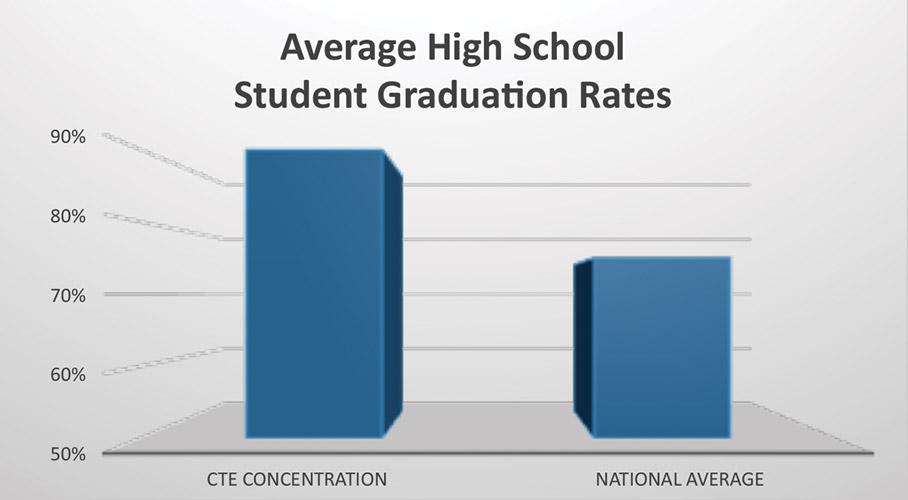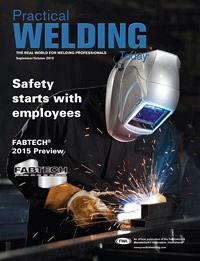President and CEO
- FMA
- The Fabricator
- FABTECH
- Canadian Metalworking
Categories
- Additive Manufacturing
- Aluminum Welding
- Arc Welding
- Assembly and Joining
- Automation and Robotics
- Bending and Forming
- Consumables
- Cutting and Weld Prep
- Electric Vehicles
- En Español
- Finishing
- Hydroforming
- Laser Cutting
- Laser Welding
- Machining
- Manufacturing Software
- Materials Handling
- Metals/Materials
- Oxyfuel Cutting
- Plasma Cutting
- Power Tools
- Punching and Other Holemaking
- Roll Forming
- Safety
- Sawing
- Shearing
- Shop Management
- Testing and Measuring
- Tube and Pipe Fabrication
- Tube and Pipe Production
- Waterjet Cutting
Industry Directory
Webcasts
Podcasts
FAB 40
Advertise
Subscribe
Account Login
Search
Closing the skills gap
Progress occurs when education and industry collaborate
- By Timm Boettcher
- September 28, 2015
- Article
- Shop Management
According to a report issued by the Pew Research Center, 10,000 baby boomers will turn 65 years old every day for the next 20 years.1 This means that over the next two decades, there is the potential for thousands of new jobs to become available that must be filled to strengthen the nation’s workforce, economic health, and global competitiveness.2,3
However, two-thirds of hiring managers say they struggle to find talented people to fill job openings.
This skills gap, or disparity between the skills job-seekers have and the skills employers need, can be seen in industries across the nation. For instance, the Manufacturing Institute reports that about 2 million of the nearly 3.5 million manufacturing jobs probably needed in the next decade will be unfilled because of a lack of qualified workers.4 The American Welding Society (AWS) estimates that by 2020, there will be a shortage of 290,000 welding professionals.5
Furthermore, the U.S. is losing ground in science, technology, engineering, and math (STEM) skills in addition to basic skills like literacy and problem solving.6 Businesses are looking not only for technical, job-related skills, but critical thinking, communication, and life skills. Simply too many jobs are available that the unemployed are inadequately trained for.
There is a solution. By participating in the development of their local and regional educational programs and ensuring that career and technical education (CTE) programs are in place, business leaders can not only help meet workforce needs, but lower training costs and gain more positive marketplace exposure.
Through collaboration, industry and education can develop the training and skill development that workers need to fill the thousands of vacancies created by retiring baby boomers in upcoming years and fill the jobs this country needs to remain globally competitive.
Filling the Skilled-Worker Pipeline
Years of research and collaboration have led the Industry Workforce Needs Coalition (IWNC) to view CTE programs as the cornerstone of building a pipeline of skilled workers and closing the skills gap across the country. Contrary to the notion that CTE programs lead to low-wage jobs that cannot compete with those available to four-year college graduates, today’s CTE programs are robust. They combine rigorous academics with relevant, career-specific training—a combination that often leads not only to a high school diploma, but an industry-recognized credential or certificate and a college degree.
In fact, the average high school graduation rate for students concentrating in CTE programs is 90 percent, compared to a national average of 75 percent. More than 70 percent of secondary students concentrating on CTE pursued postsecondary education shortly after high school.7 By engaging students with relevant, career-focused training and academic education, CTE programs can help provide the training necessary to close the skills gap and prepare today’s students for college and career.
This combination of education and training would not be possible without collaboration between industry and education leaders. Such collaboration ensures that CTE programs are providing job-specific technical skills for careers after high school; strong foundations for further postsecondary education; and even the critical thinking and problem-solving abilities, teamwork, creativity, and personal accountability that employers need in their employees.
By partnering with educational institutions, business leaders can help ensure the availability of workers with the skills and abilities businesses need for economic success.

The average high school graduation rate for students concentrating in CTE programs is 90 percent, compared to a national average of 75 percent. More than 70 percent of secondary students concentrating on CTE pursued postsecondary education shortly after high school.
Examples for Success
In December 2011 the Atlantic Council and PricewaterhouseCoopers hosted top business leaders, government entities, and academia to discuss the nation’s skills gap and offer solutions. One of those solutions was that businesses and schools must act collectively to address training issues, a proposal that remains vital today.
Following are a few examples of this collaboration:
- To help ensure the availability of skilled welders in North Carolina, Caterpillar Inc. partnered with Lee County Schools, Central Carolina Community College, and the North Carolina Department of Commerce to establish a welding youth apprenticeship program. Through this two-year program, which is the largest apprenticeship program in the state, students take welding and manufacturing-related classes in their final years of high school, then train at the college, and eventually work part-time at Caterpillar.
The program, which was established in 2012, has become an innovative and practical way for industry to fill a pipeline of skilled workers while ensuring that students leave school with marketable skills. By having the opportunity to weld alongside actual Caterpillar employees and get real-world experience, students leave the program not only with academic knowledge, but also with technical skills they can use to succeed in the workforce and in continuing education.
- The Midwest Training Center for Climate and Energy Control Technologies in Topeka, Kan., which opened in January 2013, was established through a partnership between Trane, Washburn Tech Continuing Education, and the National Coalition of Certification Centers. It uses rigorous curriculum, high-tech equipment, and industry-approved certification methods to provide training in a number of industry sectors, including energy, transportation, and advanced manufacturing. Because the center uses industry-certified training tools and curriculum, program participants graduate with the skills they need to succeed in an in-demand workforce, and with appropriate energy industry certifications. They are ready to seek some level of employment in a field that is estimated to grow 21 percent nationwide between 2012 and 2020.8
- Business leaders can also collaborate with schools by hosting tours of their facilities for students, engaging in speaking opportunities, and even mentoring students. To generate more excitement about business education in high school students, Barrington High School, Barrington, Ill., reached out to local business leaders in 2014 to establish a Business Incubator Startup course.
This unique course places students in groups to determine a product or service idea, then pairs the groups with local business leaders to research, develop, and eventually pitch their ideas to investors. Business leaders serve as coaches and mentors, guiding groups of students through the real-world process of creating, developing, and validating a business plan.
Giving students hands-on experience, this program teaches both technical skills and soft skills they can apply in careers and postsecondary education.
Like the Barrington High School business course, CTE programs developed through industry-education collaboration bring purpose to participants’ learning experience and future plans while helping meet the workforce needs of local and regional businesses.
Notes
1. https://www.pewresearch.org/daily-number/baby-boomers-retire/
2. https://www.randstadusa.com/corp/salary-guides/randstad-pharma-2014-workplace-trends-report.pdf
3. https://money.usnews.com/money/careers/articles/2012/09/10/10-businesses-that-will-boom-in-2020
4. https://www.themanufacturinginstitute.org/Research/Skills-Gap-in-Manufacturing/Skills-Gap-in-Manufacturing.aspx
5. https://www.bloomberg.com/bw/articles/2014-03-20/skilled-welder-shortage-looms-in-u-dot-s-dot-with-many-near-retirement
6. https://www.usnews.com/news/ stem-solutions/articles/2014/10/29/national-science-board-stem-data-explorer-highlights-education-jobs-growth?int=a1e909
7. https://www.acteonline.org/cte/#.VUo3NflViko
8. https://www.bls.gov/ooh/installation-maintenance-and-repair/heating-air-conditioning-and-refrigeration-mechanics-and-installers.htm
About the Author
Timm Boettcher
2709 Mondovi Road
Eau Claire, WI 54701
800-830-1416
About the Publication
subscribe now

The Welder, formerly known as Practical Welding Today, is a showcase of the real people who make the products we use and work with every day. This magazine has served the welding community in North America well for more than 20 years.
start your free subscription- Stay connected from anywhere

Easily access valuable industry resources now with full access to the digital edition of The Fabricator.

Easily access valuable industry resources now with full access to the digital edition of The Welder.

Easily access valuable industry resources now with full access to the digital edition of The Tube and Pipe Journal.
- Podcasting
- Podcast:
- The Fabricator Podcast
- Published:
- 04/30/2024
- Running Time:
- 53:00
Seth Feldman of Iowa-based Wertzbaugher Services joins The Fabricator Podcast to offer his take as a Gen Zer...
- Industry Events
Pipe and Tube Conference
- May 21 - 22, 2024
- Omaha, NE
World-Class Roll Forming Workshop
- June 5 - 6, 2024
- Louisville, KY
Advanced Laser Application Workshop
- June 25 - 27, 2024
- Novi, MI
Precision Press Brake Certificate Course
- July 31 - August 1, 2024
- Elgin,

































